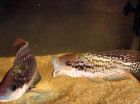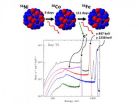(Press-News.org) This news release is available in German.
The exchange of chemical signals between organisms is considered the oldest form of communication. Acting as messenger molecules, pheromones regulate social interactions between conspecifics, for example, the sexual attraction between males and females. Fish rely on pheromones to trigger social responses and to coordinate reproductive behavior in males and females. Scientists at the Marine Science Center at the University of the Algarve in Faro, Portugal, and at the Max Planck Institute for Chemical Ecology in Jena, Germany, have now identified such a signal molecule in the urine of male Mozambique tilapia (Oreochromis mossambicus): this pheromone boosts hormone production and accelerates oocyte maturation in reproductive females. Hence, the Mozambique tilapia is one of the first fish species in which the chemical structure of a pheromone has been identified and the biological basis of its activity elucidated. (Current Biology, August 21, 2014, doi: 10.1016/j.cub.2014. 07.049)
The social behavior of Mozambique tilapias (Oreochromis mossambicus) native to southern Africa is very complex. The strict hierarchic ranking among males is fought out in so-called courtship arenas. With their mouths, male tilapias make excavations in the sand in the middle of an arena with the aim of attracting females to spawn in these nests. At the same time, they act aggressively to keep other males away. Dominant males have been observed to urinate more often and squirt larger quantities of urine in the water during fights compared to their subordinate rivals. The urine contains pheromones that reduce aggressive behavior in other males. The compounds also lure females to the nest and modify their hormonal status by accelerating oocyte maturation. Thus the pheromones help to synchronize female spawning and external fertilization by the males and so to increase the odds of reproductive success.
Tilapias also show this behavior in captivity, which makes them an ideal model system for reproducible biological assays. Tina Keller-Costa and her colleagues at the Marine Science Center at the University of the Algarve in Faro, Portugal, as well as the Biosynthesis/NMR Research Group at the Max Planck Institute for Chemical Ecology in Jena, Germany, have now identified the chemical structure of the signaling molecules in tilapia males and studied their function. She collected urine samples from dominant males and purified the samples in several steps, testing them for biological activity as pheromones after each step.
Two steroids as main components in the urine
This procedure resulted in two pure substances whose chemical structures were elucidated using nuclear magnetic resonance spectroscopy (NMR). Their identity was confirmed by chemical synthesis: "The two structures are stereoisomers or mirror images of a pregnane-type steroid linked to glucuronic acid," Bernd Schneider, the head of the NMR lab in Jena, said, summarizing the results of the analysis.
Both males and females showed highly sensitive responses to the odor of these two steroids. Although the two pheromone components stimulate the hormonal system of the females and trigger spawning, they are not by themselves capable of reducing aggressive behavior in rival males. The researchers thus assume that the urine of dominant males must contain additional yet-to-be identified substances that contribute to this effect in a complex mixture.
Until now only very few fish pheromones have been chemically identified. "Our discovery will allow for further investigations, for example, of the mechanisms of perception and processing of these chemical signals by the brain in order to originate a response, in this case oocyte maturation and behavioral changes," says Tina Keller-Costa, who conducted the experiments for her PhD thesis.
Ways to control invasive fish species and benefits for the aquaculture of food fish
Apart from the carp family, tilapias belong to the most important edible fish raised commercially. However, their aquaculture in many tropical and subtropical waters has led to an uncontrolled population growth and spread of the species. The use of pheromones could help optimize the aquaculture of tilapia species by increasing female fertility and reducing aggression between competing males. Pheromones could also help to control the invasive behavior of these fish, which threatens the ecological balance of many ecosystems. [AO/BS]
INFORMATION:
Original Publication:
Keller-Costa, T., Hubbard, P.C., Paetz, C., Nakamura, Y., da Silva, J. P., Rato, A., Barata, E. N., Schneider, B., Canario, A. V. M. (2014). Identity of a tilapia pheromone released by dominant males that primes females for reproduction. Current Biology, DOI: 10.1016/j.cub.2014. 07.049
http://dx.doi.org/10.1016/j.cub.2014.07.049
Further Information:
Dr. Bernd Schneider, Max Planck Institute for Chemical Ecology, Hans-Knöll-Straße 8, 07745 Jena, Germany. Tel. +49 3641 57-1600, E-Mail Schneider@ice.mpg.de
Picture Requests:
Angela Overmeyer M.A., Max Planck Institute for Chemical Ecology, Hans-Knöll-Str. 8, 07743 Jena, +49 3641 57-2110, overmeyer@ice.mpg.de
Download of high resolution images via http://www.ice.mpg.de/ext/735.html
Ready for mating at the right time
Researchers identify a pheromone in the urine of male tilapia fish that stimulates spawning in females
2014-08-29
ELSE PRESS RELEASES FROM THIS DATE:
China's reform of R&D budget management doesn't go far enough
2014-08-29
In almost 20 years, China's R&D expenditure as a percentage of its gross domestic product has more than tripled, reaching 1.98 per cent in 2012. This figure surpasses the 28 member states of the EU, which collectively managed 1.96 per cent.
However, despite this, China saw a sharp decline in money spent on scientific research, in particular applied research. Basic research funding plummeted from 5.2 per cent in 1995 to 4.7 per cent in 2011, and applied research funding fell from 26.4 per cent to 11.8 per cent in the same years.
This is Dr Cao's second Science article ...
Snails tell of the rise and fall of the Tibetan Plateau
2014-08-29
Boulder, Colo., USA - The rise of the Tibetan plateau -- the largest topographic anomaly above sea level on Earth -- is important for both its profound effect on climate and its reflection of continental dynamics. In this study published in GSA Bulletin, Katharine Huntington and colleagues employ a cutting-edge geochemical tool -- "clumped" isotope thermometry -- using modern and fossil snail shells to investigate the uplift history of the Zhada basin in southwestern Tibet.
Views range widely on the timing of surface uplift of the Tibetan Plateau to its current high ...
Science advice to governments comes of age at Auckland conference
2014-08-29
Auckland, New Zealand (29 August) — Science advice to governments has emerged as a discipline in its own right, which is both art and science. This is what delegates to the world's first summit of science advice heard at a meeting in Auckland, which closed today with a strong call to strengthen international collaboration, an agreement to formalise the network and meet again in 2016.
Convened by the International Council for Science (ICSU) and hosted by New Zealand's Chief Science Advisor, Sir Peter Gluckman, this historic summit marks a turning point in the global awareness ...
Intervention needed for survivors of childhood burns
2014-08-29
Adults who have been hospitalized for a burn as a child experience higher than usual rates of depression and suicidal thoughts, according to new research at the University of Adelaide.
A 30-year follow up of childhood burns victims has been conducted by the University's Centre for Traumatic Stress Studies. They found that 42% of people surveyed had suffered some form of mental illness and 30% suffered depression at some stage in their lives.
The results, now published in the journal Burns, also found that long-term depression was an issue among the group, and 11% had ...
Can YouTube save your life?
2014-08-29
Only a handful of CPR and basic life support (BLS) videos available on YouTube provide instructions which are consistent with recent health guidelines, according to a new study published in Emergency Medicine Australasia, the journal for the Australasian College for Emergency Medicine (ACEM).
Early recognition and treatment of sudden cardiac arrest are known to improve survival for
victims.
A team of Turkish emergency medicine specialists put together the study, which reviewed educational videos from the last three years accessed via YouTube when the search terms ...
Rapamycin or FK506, which is better for SCs migration and peripheral nerve repair
2014-08-29
FK506 possesses a well-studied neuroregenerative effect, stimulating neurite extension in the presence of nerve growth factor in vitro, and enhancing nerve regeneration following nerve crush injury and isografting. However, the use of FK506 to stimulate nerve regeneration is limited because of the risk of renal failure and hypertension, and its considerable cost. With long-term allografts, FK506 alone or combined with other drugs reportedly cause life-threatening infections. Like FK506, rapamycin is an immunosuppressant and FKBP-12-binding ligand, and has a neuroregenerative ...
MERS: Low transmissibility, dangerous illness
2014-08-29
The MERS coronavirus has caused disease outbreaks across the Arabian Peninsula and spread to Europe several times. The severe pneumonia virus has claimed the lives of several hundred people since its discovery in 2012. For a long time, scientists have been puzzled over how easily the pathogen spreads from human to human. An international team of researchers led by virologists from the University of Bonn have now come to the conclusion, through direct observation, that the rate of human transmission is low. Still, a third of infected persons with symptoms die. The results ...
Astrophysicists report radioactive cobalt in supernova explosion
2014-08-29
A group of astrophysicists, including researchers from MIPT, have detected the formation of radioactive cobalt during a supernova explosion, lending credence to a corresponding theory of supernova explosions. Details are given in the journal Nature, one of the most cited scientific publications in the world.
The article's main author, Yevgeny Churazov (Space Research Institute of the Russian Academy of Sciences), together with his co-authors, including Sergei Sazonov of the Space Research Institute and MIPT, reported the results of their analysis of data collected with ...
Cellphone addiction 'an increasingly realistic possibility,' Baylor study finds
2014-08-29
Women college students spend an average of 10 hours a day on their cellphones and men college students spend nearly eight, with excessive use posing potential risks for academic performance, according to a Baylor University study on cellphone activity published in the Journal of Behavioral Addictions.
"That's astounding," said researcher James Roberts, Ph.D., The Ben H. Williams Professor of Marketing in Baylor's Hankamer School of Business. "As cellphone functions increase, addictions to this seemingly indispensable piece of technology become an increasingly realistic ...
'K-to-M' histone mutations: How repressing the repressors may drive tissue-specific cancers
2014-08-29
Kansas City, MO. - In a cell's nucleus, chromosomal DNA is tightly bound to structural proteins known as histones, an amalgam biologists call chromatin. Until about two decades ago, histones were regarded as a nuclear "sidekick," the mere packing material around which the glamorous DNA strands were wrapped. Recently, however, biologists have developed a greater appreciation for how DNA/histone interactions govern gene expression.
In 2012, investigators from multiple research institutions studying the sequence of the genome from cancer patients rocked the "chromatin world" ...
LAST 30 PRESS RELEASES:
First Editorial of 2026: Resisting AI slop
Joint ground- and space-based observations reveal Saturn-mass rogue planet
Inheritable genetic variant offers protection against blood cancer risk and progression
Pigs settled Pacific islands alongside early human voyagers
A Coral reef’s daily pulse reshapes microbes in surrounding waters
EAST Tokamak experiments exceed plasma density limit, offering new approach to fusion ignition
Groundbreaking discovery reveals Africa’s oldest cremation pyre and complex ritual practices
First breathing ‘lung-on-chip’ developed using genetically identical cells
How people moved pigs across the Pacific
Interaction of climate change and human activity and its impact on plant diversity in Qinghai-Tibet plateau
From addressing uncertainty to national strategy: an interpretation of Professor Lim Siong Guan’s views
Clinical trials on AI language model use in digestive healthcare
Scientists improve robotic visual–inertial trajectory localization accuracy using cross-modal interaction and selection techniques
Correlation between cancer cachexia and immune-related adverse events in HCC
Human adipose tissue: a new source for functional organoids
Metro lines double as freight highways during off-peak hours, Beijing study shows
Biomedical functions and applications of nanomaterials in tumor diagnosis and treatment: perspectives from ophthalmic oncology
3D imaging unveils how passivation improves perovskite solar cell performance
Enriching framework Al sites in 8-membered rings of Cu-SSZ-39 zeolite to enhance low-temperature ammonia selective catalytic reduction performance
AI-powered RNA drug development: a new frontier in therapeutics
Decoupling the HOR enhancement on PtRu: Dynamically matching interfacial water to reaction coordinates
Sulfur isn’t poisonous when it synergistically acts with phosphine in olefins hydroformylation
URI researchers uncover molecular mechanisms behind speciation in corals
Chitin based carbon aerogel offers a cleaner way to store thermal energy
Tracing hidden sources of nitrate pollution in rapidly changing rural urban landscapes
Viruses on plastic pollution may quietly accelerate the spread of antibiotic resistance
Three UH Rainbow Babies & Children’s faculty elected to prestigious American Pediatric Society
Tunnel resilience models unveiled to aid post-earthquake recovery
Satellite communication systems: the future of 5G/6G connectivity
Space computing power networks: a new frontier for satellite technologies
[Press-News.org] Ready for mating at the right timeResearchers identify a pheromone in the urine of male tilapia fish that stimulates spawning in females





